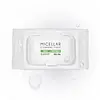What's inside
What's inside
 Key Ingredients
Key Ingredients

No key ingredients
 Benefits
Benefits

 Concerns
Concerns

 Ingredients Side-by-side
Ingredients Side-by-side

Water
Skin ConditioningPEG-6 Caprylic/Capric Glycerides
EmulsifyingPanthenol
Skin ConditioningMannitol
HumectantXylitol
HumectantFructooligosaccharides
HumectantPropylene Glycol
HumectantCucumis Sativus Juice
EmollientSodium Sulfite
PreservativePotassium Sorbate
PreservativeSodium Benzoate
MaskingPhosphoric Acid
BufferingDisodium EDTA
Cetrimonium Bromide
AntimicrobialSodium Hydroxide
BufferingCitric Acid
BufferingWater
Skin ConditioningGlycerin
HumectantPEG-6 Caprylic/Capric Glycerides
EmulsifyingPropanediol
Solvent1,2-Hexanediol
Skin ConditioningHydroxyacetophenone
AntioxidantPolyglyceryl-4 Caprate
EmulsifyingSodium Citrate
BufferingDisodium EDTA
Ethylhexylglycerin
Skin ConditioningCitric Acid
BufferingMelaleuca Alternifolia Leaf Oil
AntioxidantOlea Europaea Fruit Oil
MaskingButylene Glycol
HumectantHouttuynia Cordata Extract
Skin ConditioningVigna Radiata Seed Extract
Skin ConditioningXylitylglucoside
HumectantBeta-Glucan
Skin ConditioningAnhydroxylitol
HumectantXylitol
HumectantHelichrysum Arenarium Extract
AntiseborrhoeicGlucose
HumectantPentylene Glycol
Skin ConditioningPrunus Persica Flower Extract
MoisturisingOrchid Extract
Skin ConditioningCaprylyl Glycol
EmollientWater, Glycerin, PEG-6 Caprylic/Capric Glycerides, Propanediol, 1,2-Hexanediol, Hydroxyacetophenone, Polyglyceryl-4 Caprate, Sodium Citrate, Disodium EDTA, Ethylhexylglycerin, Citric Acid, Melaleuca Alternifolia Leaf Oil, Olea Europaea Fruit Oil, Butylene Glycol, Houttuynia Cordata Extract, Vigna Radiata Seed Extract, Xylitylglucoside, Beta-Glucan, Anhydroxylitol, Xylitol, Helichrysum Arenarium Extract, Glucose, Pentylene Glycol, Prunus Persica Flower Extract, Orchid Extract, Caprylyl Glycol
Ingredients Explained
These ingredients are found in both products.
Ingredients higher up in an ingredient list are typically present in a larger amount.
Citric Acid is an alpha hydroxy acid (AHA) naturally found in citrus fruits like oranges, lemons, and limes.
Like other AHAs, citric acid can exfoliate skin by breaking down the bonds that hold dead skin cells together. This helps reveal smoother and brighter skin underneath.
However, this exfoliating effect only happens at high concentrations (20%) which can be hard to find in cosmetic products.
Due to this, citric acid is usually included in small amounts as a pH adjuster. This helps keep products slightly more acidic and compatible with skin's natural pH.
In skincare formulas, citric acid can:
While it can provide some skin benefits, research shows lactic acid and glycolic acid are generally more effective and less irritating exfoliants.
Most citric acid used in skincare today is made by fermenting sugars (usually from molasses). This synthetic version is identical to the natural citrus form but easier to stabilize and use in formulations.
Read more about some other popular AHA's here:
Learn more about Citric AcidDisodium EDTA plays a role in making products more stable by aiding other preservatives.
It is a chelating agent, meaning it neutralizes metal ions that may be found in a product.
Disodium EDTA is a salt of edetic acid and is found to be safe in cosmetic ingredients.
Learn more about Disodium EDTAThis ingredient is derived from caprylic and capric acids. It is an emulsifier with emollient properties.
According to the manufacturer, it is hydrophilic and soluble in aqueous solutions (water). They also state this ingredient is stable in a medium pH range (~5 - 8).
As an emulsifier, it helps make oils and oil-soluble ingredients more soluble in water.
Learn more about PEG-6 Caprylic/Capric GlyceridesWater. It's the most common cosmetic ingredient of all. You'll usually see it at the top of ingredient lists, meaning that it makes up the largest part of the product.
So why is it so popular? Water most often acts as a solvent - this means that it helps dissolve other ingredients into the formulation.
You'll also recognize water as that liquid we all need to stay alive. If you see this, drink a glass of water. Stay hydrated!
Learn more about WaterXylitol is a humectant and prebiotic. It can help with dry skin.
In studies, xylitol has been shown to improve dry skin. It decreased transepidermal water loss, or when water passes through the skin and evaporates. Xylitol also showed to help improve the biomechanical properties of the skin barrier.
The prebiotic property of xylitol may also help reinforce our skin's natural microbiome. Having a healthy microbiome prevents infection by bad bacteria and helps with hydration.
As a humectant, Xylitol helps draw moisture from both the air and from deeper skin layers. This helps keep skin hydrated.
Xylitol is a sugar alcohol and commonly used as a sugar substitute. It is naturally occurring in plants such as strawberries and pumpkin.
Learn more about Xylitol